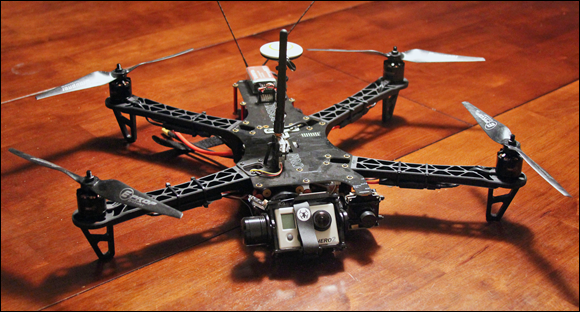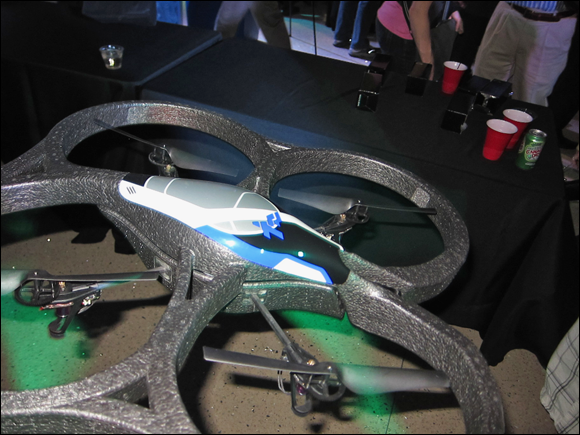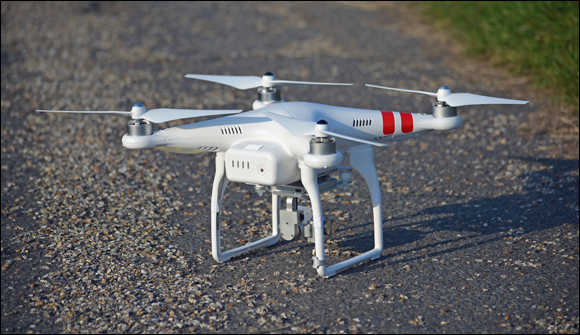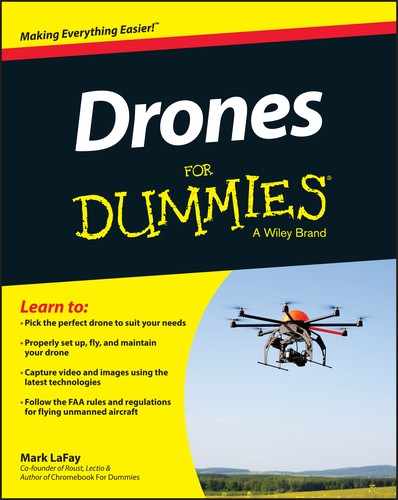Chapter 6
Staying Safe with Your Drone
In This Chapter
![]() Knowing the imminent dangers with drones
Knowing the imminent dangers with drones
![]() Exploring how to avoid propeller dangers
Exploring how to avoid propeller dangers
![]() Identifying the quirks of your drone to avoid accidents
Identifying the quirks of your drone to avoid accidents
![]() Avoiding fires with proper battery care
Avoiding fires with proper battery care
For most people, safety is something that can never be overlooked. In fact, it is a major driver in deciding what things to buy or not buy for themselves or for their loved ones. Maybe this is you. Maybe you are Ralphie’s mom in A Christmas Story, always worried that someone might shoot an eye out.
It’s funny to think about, but you can’t really discount safety. It is important that you always understand the dangers inherent with every activity in which you are participating. Potential dangers shouldn’t prevent you from participating in a given activity; it should just drive how you participate. Are fireworks dangerous? Absolutely. Can they be used safely? Absolutely!
The good news is that you can’t blow your hands off with a drone. Nor can you shoot your eye out. However, you can burn your house down, harm other people, poke an eye out, cut off fingers (or worse), cause car accidents and plane crashes, and ruin birthday parties and weddings. But don’t worry, that’s only if you don’t know what you are doing when you use your drone. The more experience you get with your drone, the safer you will become. But there is that whole inexperienced phase that you and the world around you need to be wary of. There are common sense things you can do to stay safe and then there are things that you will learn with time.
In this chapter, you learn about imminent dangers with your drone and how to safely navigate those dangers. Respect your drone propellers for the havoc they can wreak. Protect yourself and others from propeller accidents that can land you in the emergency room. Avoid accidents with your drone by learning how different features that are designed for your benefit can cause unintended accidents when not used properly. And last, explore how drone batteries work, what makes them great for use with drones, and how to properly use them so that they do not catch fire or explode.
The consumer drone market is a relatively new one, and it is growing at a rapid pace. There several mass-manufactured drones hitting the shelves thanks to companies like DJI, 3D Robotics, and Parrot. These drones come with many safety mechanisms in place designed to keep you and others free from harm. There is also a burgeoning community of hobbyists that are building drones from scratch, and in some cases for sale. Figure 6-1 is a picture of a custom built drone that is built for speed and power! These drones are designed to be more customizable by the end-user and they may not come with all of the failsafe features that the big manufacturers build into their devices.

Source: Intel Free Press/Creative Commons
Figure 6-1: Custom drones can be designed for numerous uses.
Avoiding Propeller Injuries
Propellers are the blades that are attached to the motors of your drone. When power is applied to the motors, the propellers spin at a high rate of speed. The rotation of the propeller forces air down toward the ground. This flow of air changes the relative air pressure above and below the propellers, which in turn creates lift, and your drone becomes airborne.
The size and weight of the drone largely dictate the number and size of propellers needed as well as the speed at which the propellers must spin to achieve flight. Small drones don’t pose a great risk of injury because the propellers are small, soft, and don’t rotate with nearly as much force as their big brothers, but they are still dangerous. Big drones, however, pose a great safety risk because the propellers are larger and typically made out of rigid material, such as hard plastics or carbon fiber. Coming in contact with a spinning propeller on a drone like a Parrot AR 2.0 or DJI Phantom 2 could result in substantial harm. You are almost guaranteed to be lacerated and depending on the impact this could require stitches or worse. Don’t take my word for it; Google drone propeller injuries and take a look at the images that are served up.
It goes without saying, don’t stick your hands, feet, or other objects in the path of a moving propeller. Propellers are necessary for flight, and you can’t cover them up completely because you need to be able to move air through the propellers to create lift. There are a few safety precautions that are built into most drones, or can be easily added.
Propeller guards and protective hulls
Major drone manufacturers such as DJI and Parrot build several safety mechanisms into their devices. The popular DJI Phantom drones come with propeller guards that are designed to provide a level of protection from propeller injuries that result from side impacts. In the event that your drone takes off and you or others are standing too close, an unexpected breeze could blow the drone into you, causing serious injury. The propeller guard provides some protection from this sort of scenario. Figure 6-2 shows a propeller guard that is used with the DJI Phantom drones.

Source: B Ystebo/Creative Commons, Christopher Michel/Creative Commons
Figure 6-2: Propeller guards will provide some protection from spinning propellers.
Parrot took safety a step further by creating a protective hull that attaches to the drone and pretty much turns it into an aerial bumper car. The hull is Styrofoam, so it adds negligible weight to the drone. It also provides quite a bit of protection. Figure 6-3 is a picture of the hull Parrot uses to cover the entire drone, including all four propellers.

Source: Adam Meek/Creative Commons
Figure 6-3: Parrot’s protective hull for the AR 2.0 drone.
You should notice and be aware that because the flow of air is top-down through the propellers, the props cannot be completely covered. Common sense tip number one is to not stick your fingers into moving propellers.
Safety indicators
Every drone has its own set of safety indicators, and you need to know what these are before you operate your drone. To learn how to identify where they are and what they mean, refer to your drone’s user manual.
Typically, before you can get airborne, you must arm your drone’s flight controller and motors. The process for doing this may differ from drone to drone, but the purpose is the same for every drone. Arming the drone is the last thing you do before you start flying. It tells the drone that it is go time and gives control to the controller. If your safety indicator indicates that your drone is armed, DO NOT PICK IT UP. An armed drone is ready to fly, and any movement can cause the propellers to automatically start spinning to try to stabilize the device. If you pick up an armed drone, you run the risk of injury from the propellers. Figure 6-4 is a picture of a safety indicator for a drone that is disarmed.

Source: Nan Palmero/Creative Commons
Figure 6-4: Drone safety indicators should keep you safe.
Reducing the Risk of Drone Crashes
Crashes are almost a guarantee with drone flying. There are so many causes for drone crashes that it is almost impossible to plan for and anticipate every scenario. There are, however, several things you can do to reduce the probability of a crash:
- Know your environment: Before you get airborne, be sure to scout the area. Look for towers, cables supporting vertical structures, trees, power lines, buildings, and other structures that may block your drone’s flightpath.
- Use a spotter: If you are flying with a first person view device, consider using a spotter to watch your drone. A spotter is a second person that keeps an eye on your drone, sometimes with binoculars if you are flying at long distances. First person views are restricted to the view of the camera that is streaming your flight. A spotter can help keep you from danger as long as you remain in sight.
- Use a level and stable take-off and landing location: Your drone will automatically calibrate before taking off. Make sure you have a stable, level location for taking off and landing so that your drone can calibrate accurately.
- Fly in good weather: Good weather means no wind, mild temperatures, and no precipitation.
- Battery life: If your drone’s battery is running low, you need to bring your drone home. If you don’t think you have enough juice to bring it back, slowly bring the drone back to earth and then go pick up your drone.
Even if you take all of the items above into consideration, there are several other factors that can contribute to the loss of control of your drone and a subsequent crash such as random mechanical or computer failure, battery failure, unanticipated collision with wildlife, or a run-in with a zealous anti-drone advocate.
Vortex ring state
The air that is forced down through your propellers is called downwash. Figure 6-5 is a picture showing a helicopter’s downwash on the surface of water. If your drone descends to quickly, it will descend into its downwash which will cause it to lose lift at an increasingly rapid pace. This condition is called a vortex ring state, and if it is not corrected quickly, your drone will come crashing down. You can avoid VRS simply by controlling your rate of descent. Refer to your user manual to learn a safe rate of descent for your particular drone.

Source: Vicki Burton/Creative Commons
Figure 6-5: A helicopter’s downwash is easy to see on the open water.
GPS lock
Most drones today are equipped with GPS capabilities. Before you start flying, you should ensure your drone has a GPS lock. The GPS lock tells your drone where your take-off and landing location is using GPS coordinates. This is critical in case you lose connection with your drone, regardless of whether you lose connection because the drone is flying out of range or some other communication failure occurs. With the GPS lock set, the drone should return to the GPS locked location.
This feature is fantastic in the event you do lose communication with your drone. Without a GPS lock, the drone flies until it runs out of juice or collides with something.
Be warned that some drones do not forget their GPS lock. This means that you must be sure to reset the GPS lock every time you fly your drone if you are flying in different locations. Otherwise if your drone goes out of range, it may try to return to a different location entirely because of the GPS lock.
Safely Handling Lithium Polymer Batteries
For the most part, the go-to battery used in drones is a lithium polymer battery (LiPo for short). Most LiPo batteries are not a true lithium polymer batteries but rather a hybrid between two battery technologies. First and foremost, batteries use chemical reactions to produce electricity. A true lithium polymer battery creates electricity with a chemical reaction between dry components. Unfortunately, this doesn’t create electrical current at a rate that is necessary for drone motors. So drones use a hybrid battery that combines wet and dry chemicals to facilitate the reaction at the rate necessary to power high-energy consumers such as drones.
LiPo batteries are ideal for drones because they can be built in many shapes and sizes, they have a favorable size to power ratio, and they have a high energy discharge rate which is ideal for electric motors. But for all of their benefits for use in drones, LiPo batteries are still very dangerous if not cared for correctly.
Properly charging a LiPo battery
The most common way to damage a LiPo battery is by overcharging it. Overcharging a battery can cause your battery to swell like the one shown in Figure 6-6. Swollen batteries can catch fire and explode. Over-discharging your battery can also cause issues if it remains un-charged long enough. The battery chemicals can come out of solution and cause the battery to short when you attempt to charge it again. A LiPo battery that is shorting out internally can explode and catch fire.

Source: U.S. Navy photo by Photographer's Mate Airman Sarah E. Ard
Figure 6-6: Bury swollen LiPo batteries in a bucket of sand.
Most drones come with proprietary battery shapes and connectors. This is probably more of a function of commerce than safety, but regardless, use only the charges designated for your drone’s batteries. If you buy an aftermarket charger, be sure to read your drone’s manual to ensure that your charger has all the proper safety mechanisms to ensure you never overcharge.
Avoiding dropping or crashing your LiPo battery
LiPo batteries are also very fragile. So fragile that simply dropping a LiPo battery on the floor can damage a cell and cause the chemicals within the battery to react uncontrollably. If your drone is involved in a crash, you will want to ensure that the battery did not withstand any damage. Placing a damaged battery on the charger can result in a fire.
Safely disposing of LiPo batteries
LiPo batteries are typically considered to be beyond usable life once they degrade to about 20 percent of their original capacity. At this point, you should stop flying with the battery as it may fully discharge before you can safely land your drone.
LiPo batteries can’t simply be thrown away in the garbage can. While they may not be fit to fly, they can still be quite dangerous. Before throwing your battery away, you must first completely discharge the electrical charge. Most chargers come with a discharge feature that will drain the power from the battery rendering it fit for the garbage can.
If your battery is damaged or swollen, you still need to discharge the battery before tossing it out. You should not put it back onto the charger to discharge it. A common way for discharging damaged LiPo batteries involves connecting it to a light bulb and burying the battery in a bucket of sand until it is fully discharged. The safest option, however, would be to take it to your local hobby shop and let the experts dispose of it. If you can’t get to a hobby shop right away, put the damaged battery into a bucket of sand until you can get to one.

 Regardless of the drone you have or intend to purchase, there are several obvious dangers associated with using a drone. For this reason, drones shouldn’t be regarded as innocuous toys; rather, they should be respected and used with great care. Doing so will help you avoid unnecessary damage to your drone and personal injury.
Regardless of the drone you have or intend to purchase, there are several obvious dangers associated with using a drone. For this reason, drones shouldn’t be regarded as innocuous toys; rather, they should be respected and used with great care. Doing so will help you avoid unnecessary damage to your drone and personal injury. The DJI Phantom had a known bug that would cause Phantoms to fly away upon arming. The device would think that it was out of range, and it would automatically take off in the direction of the previous GPS lock. Since the writing of this book, DJI has provided a software update to fix this bug, it’s still a good idea to be aware of this in the event you’re ever flying a drone that behaves in this manner.
The DJI Phantom had a known bug that would cause Phantoms to fly away upon arming. The device would think that it was out of range, and it would automatically take off in the direction of the previous GPS lock. Since the writing of this book, DJI has provided a software update to fix this bug, it’s still a good idea to be aware of this in the event you’re ever flying a drone that behaves in this manner.